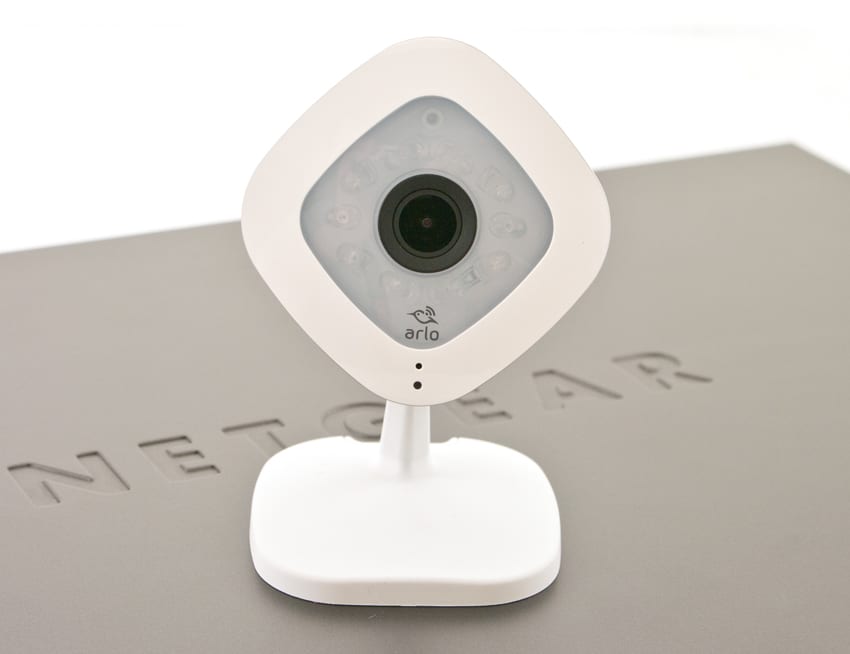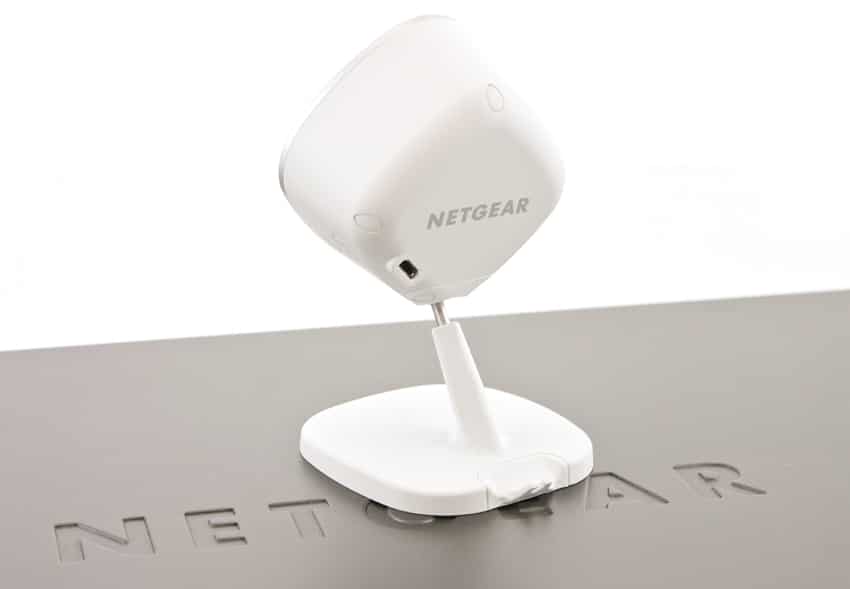 The Netgear Arlo surveillance system is well known for being the easiest to set up for a home or small business/remote office. We run a few Arlo systems both in the lab and at home; the wireless cameras can go just about anywhere. An all wireless system has drawbacks though, primarily the Arlo cameras require batteries that must be replaced at regular intervals depending on the frequency and duration of recording the user configures. As the platform continues to mature though, Netgear recognized this issue and has since launched Arlo Q and Q Plus cameras. The Q cameras are wired, which gets around the battery issue, and they bring a slew of new features like two-way voice, 1080p resolution and support for continuous video recording with an optional Arlo plan upgrade. Like the standard wireless units, they connect to the Arlo base station over WiFi; the Arlo Q simply plugs into a wall outlet for power where the Q Plus gets power over Ethernet.
The Netgear Arlo surveillance system is well known for being the easiest to set up for a home or small business/remote office. We run a few Arlo systems both in the lab and at home; the wireless cameras can go just about anywhere. An all wireless system has drawbacks though, primarily the Arlo cameras require batteries that must be replaced at regular intervals depending on the frequency and duration of recording the user configures. As the platform continues to mature though, Netgear recognized this issue and has since launched Arlo Q and Q Plus cameras. The Q cameras are wired, which gets around the battery issue, and they bring a slew of new features like two-way voice, 1080p resolution and support for continuous video recording with an optional Arlo plan upgrade. Like the standard wireless units, they connect to the Arlo base station over WiFi; the Arlo Q simply plugs into a wall outlet for power where the Q Plus gets power over Ethernet.
The Netgear Arlo surveillance system is well known for being the easiest to set up for a home or small business/remote office. We run a few Arlo systems both in the lab and at home; the wireless cameras can go just about anywhere. An all wireless system has drawbacks though, primarily the Arlo cameras require batteries that must be replaced at regular intervals depending on the frequency and duration of recording the user configures. As the platform continues to mature though, Netgear recognized this issue and has since launched Arlo Q and Q Plus cameras. The Q cameras are wired, which gets around the battery issue, and they bring a slew of new features like two-way voice, 1080p resolution and support for continuous video recording with an optional Arlo plan upgrade. Like the standard wireless units, they connect to the Arlo base station over WiFi; the Arlo Q simply plugs into a wall outlet for power where the Q Plus gets power over Ethernet.

Arlo Q Specifications
- Video & Audio
- Resolution: 1080p HD 30fps
- Format: h.264
- Field of view: 130°
- Night Vision
- 850nm LED: up to 25 feet
- Imaging Sensor
- Full color
- CMOS
- 8x digital zoom
- Audio
- Speaker
- Microphone
- Motion Detection
- Adjustable up to 50 feet
- Up to 3 activity zones
- Instant email alerts and push notifications
- Interface
- FREE apps for iOS, Android, and FireOS
- Live streamed or recorded videos from your
- smart phone, tablet or browser
- Easy to use, intuitive user interface
- Free secure cloud storage included
- Wireless
- Frequency: 2.4 & 5GHz
- WiFi Speed: N600
- Range: 300 feet line of sight
- Power
- AC power varies by region
- Dimensions: 2.75 x 2.80 x 4.50 in
Usability
The Arlo Q looks more like a traditional webcam than the original Arlo camera. The design differences come down to the different layout for the IR-illuminators as well as the lack of battery bay since the camera is powered directly off of its micro-USB connection. So while the camera has a bit larger front profile, it is less deep than the wire-free cameras.

The Arlo Q also includes its own built-in moveable stand to mount and position the camera. The foot has very strong magnets integrated into it, which makes positioning on a metal surface very easy. There are also screw slots for attaching it to non-magnetic surfaces.
On image and video quality, the Arlo Q steps up its game with a 1080P sensor, versus 720P in the wire-free models. It also offers a wider-field of vision with a 130-degree field of view versus 110-degree of the wire-free Arlo.
Moving onto the camera itself, the wired camera does offer some distinct advantages over the battery-powered models. Two-way audio is now offered, as well as a higher-quality video stream. This lets you mount the camera at the back of a room and capture more space, leveraging the increased video resolution to identify what’s going on. The wired camera also lets you constantly stream and record video, something that while technically possible on the wire-free models, would deplete the batteries very quickly. Without power being a concern, Netgear offers a timeline style of recording, instead of just “windows in time” from when the previous cameras detected motion. This feature while offered, isn’t included in the free subscription service.
For businesses or homeowners looking to easily deploy security cameras, the Arlo Q has much more of a set and forget deployment model. While the Arlo wire-free was easy to setup, it does require on-going maintenance in the form of replacement batteries depending on how often it records video. The Arlo Q fixes that, for a trade-off in mounting flexibility, allowing someone to setup the camera and never worry about it again as long as it has a connection to Wi-Fi. This offers a level of comfort to users knowing they won’t be without camera security if a set of batteries get depleted before they remember to swap them out.
Conclusion
The Arlo Q camera fills a gap in the portfolio by solving the battery replacement issues inherent in the purely wireless cameras. For environments that can plug in a camera, the Q does very nicely in the home or small business, whereas the Q Plus leverages PoE in more IT mature environments. Just like adding new wireless cameras to the Arlo system, the Q is simple to discover using the Arlo app or web browser. From there it’s managed just like all the other cameras, with the exception of new feature elements that the base cameras don’t include.
